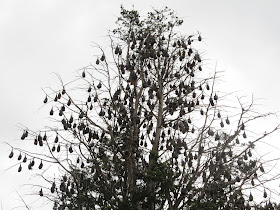Besides the fact that a darkened river track is not the best place for a lone female, there are other factors which make it tricky to gather material for a nocturnal blog post. Not least of these is the fact that my camera is really not up to the challenge of night photography and to be honest, neither is the photographer!
One of these days I might get the right equipment and take a course which teaches me how to use it, but until then, I will have to make do with a few blurry shots taken during an occasional early evening stroll with the family.
So, what is out there on the cool, dark banks of the Barwon? Well, probably quite a bit that I have yet to notice, but also a number of things which I have experienced. Firstly, there are those nocturnal creatures which - conveniently enough for me - are happy to make an appearance during daylight hours. The so-called Nankeen Night Heron which I have shown in several previous posts does not seem to discriminate too much as to time of day or night. Nor for that matter do mosquitoes! I have also caught the occasional Possum of indeterminate species blinking at me from the foliage of an overhead branch, but my only photos have been nocturnal.
 |
| Probably a Common Brushtail Possum (if you look on just the right angle) |
I imagine that they are members of the colony of flying-foxes which took up residence in Eastern Park overlooking Corio Bay in 2003 after being evicted from the botanic gardens in Melbourne. Just on dusk and well into the evening, these fairly substantially-sized bats can be seen flying out from the gardens to look for food. On a warm evening, hundreds of them pass over our house, heading south-westerly towards the Barwon. The flapping of their wings is quite distinct and not at all like that of a bird.
 |
| Grey-headed Flying-fox in the Eastern Park colony |
 |
| A very odd Christmas tree! |
The racket made by the colony as they hang from the branches like some form of macabre black fruit can be quite loud. This is, I am informed, the way parents communicate with their offspring during the summer months. The other means of communication is by smell - and that can be quite pronounced too!
 |
| Bats in the Eastern Park colony |
 |
| Good night! |
Finally, there is one other nocturnal breed which can sometimes be found lurking along the banks of the Barwon after dark and that is of course the geocacher. For those in need of enlightenment the Geocaching.com website will help. In addition to the expected array of caches which can be located at any hour of the day or night, there is a rather devilish night cache located towards the Breakwater section of the river which took us several hours and three trips to track down during which time we heard many rustlings but saw little in the way of nocturnal wildlife.
Well these are just a few of the nocturnal beasties I have seen along the river to date and as long as the weather holds for a while yet, I will hopefully be able to venture out to see if I can acquaint myself with a few more creatures of the night along the lengths of the Barwon.
No comments:
Post a Comment